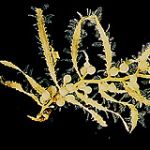| Common Name: |
Gulfweed |
| Other Names: |
Moku |
| Botanical Name: |
Sargassum fusiforme |
| Genus: |
Sargassum |
| Family: |
Sargassaceae |
| Native Location: |
Off the coasts of China, Japan, and Korea |
| Cultivation: |
Grows on partly submerged rocks between high tide and low tide zones. |
| Propagation: |
By holdfasts being left to regenerate. |
| Harvest: |
Whole plants are collected in winter and spring, and dried for decoctions and powders. |
| Height: |
20-50cm (8-16in) |
| :Width |
20-50cm (8-16in) |
| Parts Used: |
Whole plant (hai zao). |
| Properties: |
A bitter, saline, cooling herb that is expectorant and diuretic, controls bleeding, lowers blood pressure and lipid levels, softens hard swellings, acts on thyroid and suppresses appetite. |
| Medicinal Uses: |
Internally for goiter, edema, bronchitis, tuberculosis of lymph nodes, cysts, and hydrocele. Externally for hemorrhage. |
| Bibliography: |
Encylopedia of Herbs by Deni Brown Copyright ©: 1995, 2001 Dorling Kindersley Limited pp 360-361
|

